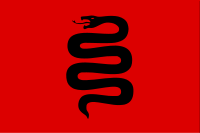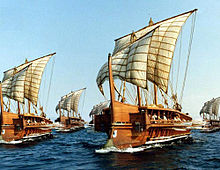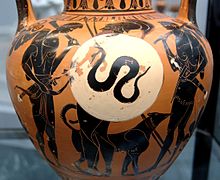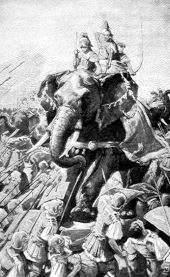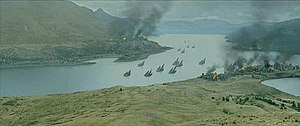Denethor II, son of Ecthelion II, is a fictional character in J. R. R. Tolkien's novel The Lord of the Rings. He was the 26th ruling Steward of Gondor, committing suicide in the besieged city of Minas Tirith during the Battle of the Pelennor Fields.

Gondor is a fictional kingdom in J. R. R. Tolkien's writings, described as the greatest realm of Men in the west of Middle-earth at the end of the Third Age. The third volume of The Lord of the Rings, The Return of the King, is largely concerned with the events in Gondor during the War of the Ring and with the restoration of the realm afterward. The history of the kingdom is outlined in the appendices of the book.
Éomer is a fictional character in J. R. R. Tolkien's Middle-earth. He appears in The Lord of the Rings as a leader of the Riders of Rohan who serve as cavalry to the army of Rohan, fighting against Mordor.
In J. R. R. Tolkien's Middle-earth fiction, Man and Men denote humans, whether male or female, in contrast to Elves, Dwarves, Orcs, and other humanoid races. Men are described as the second or younger people, created after the Elves, and differing from them in being mortal. Along with Ents and Dwarves, these are the "free peoples" of Middle-earth, differing from the enslaved peoples such as Orcs.

Rohan is a fictional kingdom of Men in J. R. R. Tolkien's fantasy setting of Middle-earth. Known for its horsemen, the Rohirrim, Rohan provides its ally Gondor with cavalry. Its territory is mainly grassland. The Rohirrim call their land the Mark or the Riddermark, names recalling that of the historical kingdom of Mercia, the region of Western England where Tolkien lived.
The Battle of the Pelennor Fields, in J. R. R. Tolkien's novel The Lord of the Rings, was the defence of the city of Minas Tirith by the forces of Gondor and the cavalry of its ally Rohan, against the forces of the Dark Lord Sauron from Mordor and its allies the Haradrim and the Easterlings. It was the largest battle in the War of the Ring. It took place at the end of the Third Age in the Pelennor Fields, the townlands and fields between Minas Tirith and the River Anduin.
In J. R. R. Tolkien's epic fantasy novel The Lord of the Rings, the Battle of the Morannon or the Battle of the Black Gate, is the final confrontation in the War of the Ring. Gondor and its allies send a small army ostensibly to challenge Sauron at the entrance to his land of Mordor; he supposes that they have with them the One Ring and mean to use it to defeat him. In fact, the Ring is being carried by the hobbits Frodo Baggins and Sam Gamgee into Mordor to destroy it in Mount Doom, and the army is moving to distract Sauron from them. Before the battle, a nameless leader, the "Mouth of Sauron", taunts the leaders of the army with the personal effects of Frodo and Sam. Battle is joined, but just as it seems the army of Gondor will be overwhelmed, the Ring is destroyed, and the forces of Sauron lose heart. Mount Doom erupts, and Sauron's tower, Barad-dûr, collapses, along with the Black Gate. The army of Gondor returns home victorious, the War of the Ring won.

In J. R. R. Tolkien's legendarium, the history of Arda, also called the history of Middle-earth, began when the Ainur entered Arda, following the creation events in the Ainulindalë and long ages of labour throughout Eä, the fictional universe. Time from that point was measured using Valian Years, though the subsequent history of Arda was divided into three time periods using different years, known as the Years of the Lamps, the Years of the Trees, and the Years of the Sun. A separate, overlapping chronology divides the history into 'Ages of the Children of Ilúvatar'. The first such Age began with the Awakening of the Elves during the Years of the Trees and continued for the first six centuries of the Years of the Sun. All the subsequent Ages took place during the Years of the Sun. Most Middle-earth stories take place in the first three Ages of the Children of Ilúvatar.
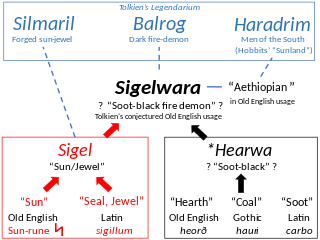
"Sigelwara Land" is an essay by J. R. R. Tolkien that appeared in two parts, in 1932 and 1934. It explores the etymology of the Old English word for the ancient Aethiopians, Sigelhearwan, and attempts to recover what it might originally have meant. Tolkien suggested that its two elements were most likely sun/jewel and coal/hearth, perhaps meaning something like a soot-black fire-demon.
The fictional races and peoples that appear in J. R. R. Tolkien's fantasy world of Middle-earth include the seven listed in Appendix F of The Lord of the Rings: Elves, Men, Dwarves, Hobbits, Ents, Orcs and Trolls, as well as spirits such as the Valar and Maiar. Other beings of Middle-earth are of unclear nature such as Tom Bombadil and his wife Goldberry.
Scholars and critics have identified many themes of The Lord of the Rings, a major fantasy novel by J. R. R. Tolkien, including a reversed quest, the struggle of good and evil, death and immortality, fate and free will, the danger of power, and various aspects of Christianity such as the presence of three Christ figures, for prophet, priest, and king, as well as elements like hope and redemptive suffering. There is also a strong thread throughout the work of language, its sound, and its relationship to peoples and places, along with moralisation from descriptions of landscape. Out of these, Tolkien stated that the central theme is death and immortality.
Magic in Middle-earth is the use of supernatural power in J. R. R. Tolkien's fictional Middle-earth. Tolkien distinguishes ordinary magic from witchcraft, the latter always deceptive, stating that either type could be used for good or evil.
In J. R. R. Tolkien's Middle-earth writings, the Dúnedain were a race of Men, also known as the Númenóreans or Men of Westernesse. Those who survived the sinking of their island kingdom and came to Middle-earth, led by Elendil and his sons, Isildur and Anárion, settled in Arnor and Gondor.
Númenor, also called Elenna-nórë or Westernesse, is a fictional place in J. R. R. Tolkien's writings. It was the kingdom occupying a large island to the west of Middle-earth, the main setting of Tolkien's writings, and was the greatest civilization of Men. However, after centuries of prosperity many of the inhabitants ceased to worship the One God, Eru Ilúvatar, and rebelled against the Valar, resulting in the destruction of the island and the death of most of its people. Tolkien intended Númenor to allude to the legendary Atlantis. Commentators have noted that the destruction of Númenor echoes the Biblical stories of the fall of man and the destruction of Sodom and Gomorrah, and John Milton's Paradise Lost.
Théoden is a fictional character in J. R. R. Tolkien's fantasy novel, The Lord of the Rings. The King of Rohan and Lord of the Mark or of the Riddermark, names used by the Rohirrim for their land, he appears as a supporting character in The Two Towers and The Return of the King. When first introduced, Théoden is weak with age and sorrow and the machinations of his top advisor, Gríma Wormtongue, and he does nothing as his kingdom is crumbling. Once roused by the wizard Gandalf, however, he becomes an instrumental ally in the war against Saruman and Sauron, leading the Rohirrim into the Battle of the Pelennor Fields.
The Lord of the Nazgûl, also called the Witch-king of Angmar, the Pale King, and the Black Captain, is a fictional character in J. R. R. Tolkien's fantasy novel The Lord of the Rings. He had once been the King of Angmar in the north of Eriador. He is the bearer of a Ring of Power, one of the nine that the dark lord Sauron gave to Men, who become the Nazgûl or Ringwraiths. This gives him great power, but enslaves him to Sauron and makes him invisible. By the end of the Third Age, his name has been forgotten. He stabs the bearer of the One Ring, the Hobbit Frodo Baggins, with a Morgul-knife which would reduce its victim to a wraith. Much later in the narrative, in his final battle, the Lord of the Nazgûl attacks Éowyn with a mace. The Hobbit Merry Brandybuck stabs him with an ancient enchanted Númenórean blade, allowing Éowyn to kill him with her sword.
Aragorn is a fictional character and a protagonist in J. R. R. Tolkien's The Lord of the Rings. Aragorn was a Ranger of the North, first introduced with the name Strider and later revealed to be the heir of Isildur, an ancient King of Arnor and Gondor. Aragorn was a confidant of the wizard Gandalf, and played a part in the quest to destroy the One Ring and defeat the Dark Lord Sauron. As a young man, Aragorn fell in love with the immortal elf Arwen, as told in "The Tale of Aragorn and Arwen". Arwen's father, Elrond Half-elven, forbade them to marry unless Aragorn became King of both Arnor and Gondor.
Elrond Half-elven is a fictional character in J. R. R. Tolkien's Middle-earth legendarium. Both of his parents, Eärendil and Elwing, were half-elven, having both Men and Elves as ancestors. He is the bearer of the elven-ring Vilya, the Ring of Air, and master of Rivendell, where he has lived for thousands of years through the Second and Third Ages of Middle-earth. He was the Elf-king Gil-galad's herald at the end of the Second Age, saw Gil-galad and king Elendil fight the dark lord Sauron for the One Ring, and Elendil's son Isildur take it rather than destroy it.

In J. R. R. Tolkien's fictional world of Middle-earth, Mordor is the realm and base of the evil Sauron. It lay to the east of Gondor and the great river Anduin, and to the south of Mirkwood. Mount Doom, a volcano in Mordor, was the goal of the Fellowship of the Ring in the quest to destroy the One Ring. Mordor was surrounded by three mountain ranges, to the north, the west, and the south. These both protected the land from invasion and kept those living in Mordor from escaping.
The geography of Middle-earth encompasses the physical, political, and moral geography of J. R. R. Tolkien's fictional world of Middle-earth, strictly a continent on the planet of Arda but widely taken to mean the physical world, and Eä, all of creation, as well as all of his writings about it. Arda was created as a flat world, incorporating a Western continent, Aman, which became the home of the godlike Valar, as well as Middle-earth. At the end of the First Age, the Western part of Middle-earth, Beleriand, was drowned in the War of Wrath. In the Second Age, a large island, Númenor, was created in the Great Sea, Belegaer, between Aman and Middle-earth; it was destroyed in a cataclysm near the end of the Second Age, in which Arda was remade as a spherical world, and Aman was removed so that Men could not reach it.
